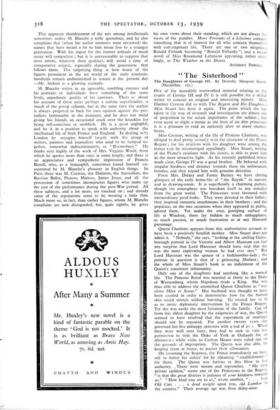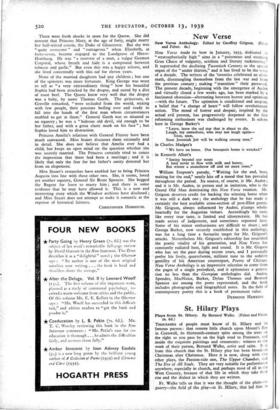" The Sisterhood "
The Daughters of George III. By Dorothy Margaret Stuart. (Macmillan. iss.)
Our of the incredibly overworked material relating to the courts of George III and IV it is still possible for a skilful writer to concoct an original and interesting history. Miss Dormer Creston did so with The Regent and His Daughter; Miss Stuart has done it again. The pains which she has taken in the way of research and investigation are almost out of proportion to the actual importance of the subject ; but even upon so slight a theme as the lives of six dim princesses it is a pleasure to read an authority after so many chatter- boxes.
Miss Creston, writing of the life of Princess Charlotte, was obliged to deal pretty severely with the character of the Prince Regent ; for his relations with his daughter were among the things that he mismanaged appallingly. Miss Stuart, writing of the Prince's relations with his sisters, is able to paint him in the most attractive light. As his recently published letters made clear, George 1V was a good brother. He behaved with singular kindness and decency towards these six unfortunate females, and they repaid him with genuine devotion.
From Mrs. Delany and Fanny Burney we have cloying glimpses of the early home-life of " the Royals " in nursery and in drawing-room. It is superficially a charming picture, though the atmosphere was boredom itself to any outsider from the great world. The Princesses were favoured with extraordinary good looks. They were devoted to their father ; they inspired romantic attachments in their brothers ; and the populace, on the rare occasions when they appeared in public, adored them. Yet under the cosy, gossiping surface of life at Windsor, there lay hidden as much unhappiness, as much passion, as much frustration as at any Haworth parsonage.
Queen Charlotte appears from this authoritative account to have been a positively fiendish mother. Miss Stuart does not
admit it. " Nobody," she says, " looking at the smiling Gains- borough portrait in the Victoria and Albert Museum can feel any surprise that Lord Harcourt should have said that she
was the most captivating woman he had ever met." But Lord Harcourt was the spouse of a bedchamber-lady ; the portrait in question is that of a grimacing Medusa ; and the whole of Miss Stuart's book is an indictment of the Queen's consistent inhumanity.
Only one of the daughters had anything like a normal life. The Princess Royal was married at thirty to the Duke
of Wurtemberg, whom Napoleon made a King. She was thus able to address the astonished Queen Charlotte as " tres there Mere et Soeur." Her husband was thought to have
been created in order to demonstrate how far the human skin could stretch without bursting. He treated her so ill as to invite diplomatic intervention by the Prince Regent. Yet she was easily the most fortunate of the family. Cut off from this eldest daughter by the exigencies of war, the Queen seemed to have resolved that the experiment of marriage should not be repeated. For another twenty years she
governed her five unhappy spinsters with a rod of irc -I. When they .were well over forty, they had to seek in vain her permission to visit the Duke of York at Oatlands for an afternoon ; while visits to Carlton House were ruled out 00 the grounds of impropriety. The Queen was also able, by keeping them at home, to pocket their allowances.
On assuming the Regency, the Prince immediately set him- self to better his sisters' lot by obtaining " establishments "
for them. The Queen was furious at this blow to her authority. .There were storms and reproaches. "My own private opinion," wrote one of the Princesses to the Regent, " is that the great distress is jealousy of your kindness towards us." " How kind you are to us," wrote another, " . . Old Cats . . . a dead weighi upon you, old Lumber to the country." Their average age was then thirty-nine. four
There were fresh shocks in store for the Queen. She did consent that Princess Mary, at the age of forty, might marry her half-witted cousin, the Duke of Gloucester. But she was " quite overcome " and " outrageous " when Elizabeth, at forty-seven, became engaged to the Landgrave of Hesse- Homburg. He was " a monster of a man, a vulgar German Corporal, whose breath and hide is a compound between tobacco and garlic." But even this was a happy release, and she lived contentedly with this oaf for eleven years.
None of the married daughters had any children ; but one of the spinsters was more fortunate. King George was wont to tell as " a very extraordinary thing " how his beautiful Sophia had been attacked by the dropsy, and cured by a diet of roast beef. The Queen knew very well that the dropsy was a baby, by name Thomas Garth. The princesses, as Greville remarked, " were secluded from the world, mixing with few people, their passions boiling over and ready to fall into the hands of the first man whom circumstances enabled to get at them." General Garth was so situated as an equerry ; he was a " hideous old devil, old enough to be her father, and with a great claret mark on his face " ; but Sophia loved him to distraction.
Princess Amelia's relations with General Fitzroy have been much canvassed. Miss Stuart discusses them rationally and in detail. She does not believe that Amelia ever had a child, but keeps an open mind on the question whether she was secretly married. The Princess certainly tried to create the impression that there had been a marriage ; and it is likely that only the fear for her father's sanity deterred her from an elopement.
Miss Stuart's researches have enabled her to bring Princess Augusta into line with these other two. She, it seems, loved yet another equerry, General Sir Brent Spencer. She begged the Regent for leave to marry him ; and there is some evidence that he may have allowed it. This is a new and interesting story which the Windsor archives have disclosed ; and Miss Stuart does not attempt to make it romantic at the expense of historical fairness.
CHRISTOPHER HOBHOUSE.











































 Previous page
Previous page